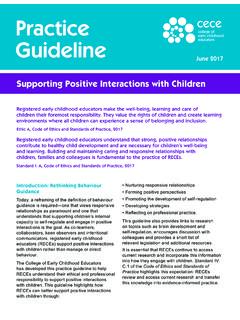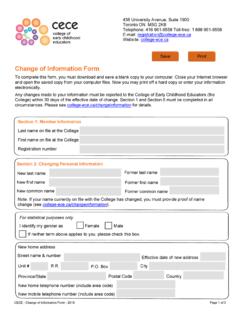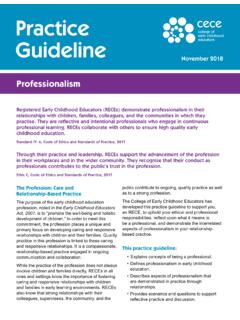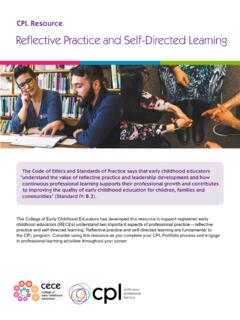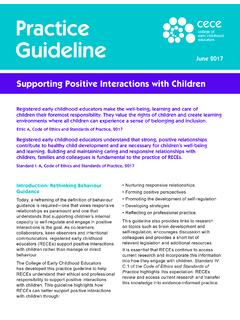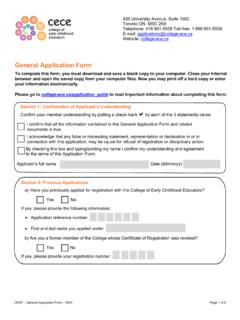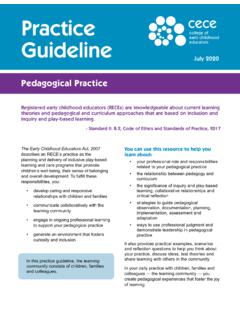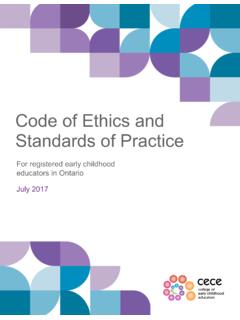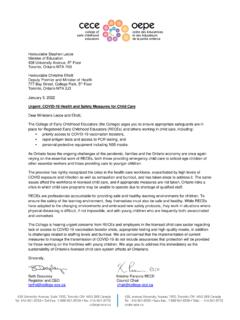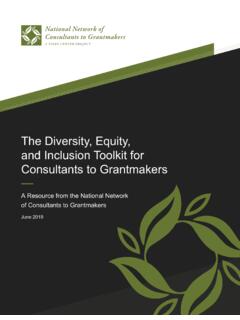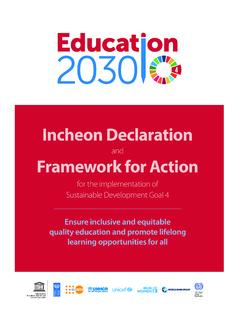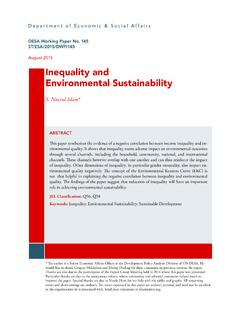Transcription of Practice Guideline: Diversity and Culture
1 Practice Guideline October 2020. Diversity and Culture Registered Early Childhood Educators (RECEs) respond to the uniqueness of individuals and groups of children. They identify appropriate strategies, access the necessary resources and design curriculum to ensure full participation of all children, taking into account ability, cultural and linguistic Diversity and Indigenous identity. They provide all children with opportunities for engagement, exploration and expression. - Standard II: , Code of Ethics and Standards of Practice , 2017. The Code of Ethics and Standards of Practice (Code and Standards) demonstrates a respect for Diversity and a sensitivity to the multicultural character of the Province (Early Childhood Educators Act, 2007).
2 It outlines the profession's core beliefs and values that are care, respect, trust and integrity. All RECEs are responsible for upholding them to guide their professional Practice and conduct. More attention is being placed on becoming aware of and understanding what Diversity and Culture mean in theory and professional Practice . Learning on this topic includes ongoing self-reflection and collaboration with others to become aware of the cultural differences and similarities among individuals and groups of people. This resource is designed to help you co-create welcoming and supportive environments with children, families and colleagues from various communities, nations, cultures, backgrounds and social structures that may differ from your own.
3 You can use this resource to help you learn about: the importance of reflecting on your beliefs and bias, and to consider how they influence Practice ;. ways to build relationships and communicate across differences;. how to co-create culturally responsive, inclusive learning environments that embed diverse perspectives; and, the significance of leadership in inclusive Practice and policy development and review. Figure 1: Educator with a group of children outdoors About this Publication Practice guidelines communicate certain expectations of Registered Early Childhood Educators as outlined in the Code of Ethics and Standards of Practice . Guidelines also highlight how those expectations may be applied in Practice . They include recommendations and provide opportunities for self-reflection and professional learning.
4 The Code and Standards, current research and related legislation should be consulted when considering Practice guidelines. Practice guidelines support the College's role to promote high standards and continuous professional learning and to govern the conduct of RECEs. Visit to access all the guidelines. 2 October 2020 | Practice Guideline: Diversity and Culture | College of Early Childhood Educators Table of Contents What are Diversity and Culture ? 4. Learning about Diversity and Culture 7. Indigenous peoples in Canada 9. Reflecting on beliefs and bias 10. Developing culturally responsive relationships 17. Communicating across differences 20. Reflecting Diversity and Culture in the learning environment 24. Demonstrating inclusive leadership 29.
5 Scenarios and reflective questions 33. Aren't you the nanny? 33. My hair, my crown! 34. Respect for Indigenous Culture 35. It's too loud! 36. References 37. Suggestions for using the Practice Guideline: Take your time to review the material and additional resources. Focus on areas that are most relevant to your current Practice or sections that challenge you. Engage in collaborative enquiry and critical reflection during a staff or team meeting, or share in a community of Practice . Actively engage in collaborative discussions to reflect on, challenge and question the complexities of Practice . Use this resource to support you with your related Continuous Professional Learning (CPL) portfolio goals and activities. College of Early Childhood Educators | Practice Guideline: Diversity and Culture | October 2020 3.
6 What are Diversity and Culture ? Diversity and Culture can be defined in many different ways in various documents by different cultural groups and organizations. For consistency, this resource will draw on the definitions found in the Code and Standards which states: Diversity is the difference and uniqueness that each person brings to the early-years setting. Culture is the understanding, pattern of behaviour, practices and values that a group of people share. The Code of Ethics says that RECEs recognize the uniqueness and Diversity of children and families. They respect each child's potential and develop and maintain responsive relationships with children and their families. RECEs provide them with meaningful opportunities to engage in and contribute to the learning environment.
7 As an RECE, you also establish positive, collaborative relationships with your colleagues by demonstrating respect, trust and integrity. To truly appreciate diverse cultures, you need to develop an understanding that people come from and have multiple social identities and different values and ways of knowing and being in the world (Ontario Ministry of Education, 2013). Children, families and staff in early years settings are diverse in many ways. Some will identify as belonging to one or more cultural groups. Cultural groups can be made up of people from a particular religion, race or country of origin, but cultural groups are also formed by members of communities who share gender identity, interests, language, life experiences, family structure, trauma, disability, sexual orientation or socio-economic status, to name a few.
8 Members of a cultural group share similar beliefs, values, practices and experiences yet individuals within these same groups are diverse. With this in mind, RECEs, in addition to the children, families and the professionals they work with, will belong to different cultural and social groups, and hold a wide range of beliefs, values, practices and experiences. All RECEs are as unique as the children, families and colleagues with whom they work. In this Practice guideline, the learning community consists of children, families and colleagues. 4 October 2020 | Practice Guideline: Diversity and Culture | College of Early Childhood Educators Figure 2: Visible and invisible aspects of Diversity College of Early Childhood Educators | Practice Guideline: Diversity and Culture | October 2020 5.
9 Here are some examples of the diverse cultural contexts of individuals and families: A parent in your learning environment A school-age child in your Practice moved from Quebec to live in Ontario. setting was raised in an adoptive He is bilingual in French and English family who recently helped him and teaches in a French-language reconnect with his mother, an Inuk school board. He is a single parent, woman. The child is learning to speak raising his son on his own. While his Inuktitut through Elders in the birth family visits from Quebec twice a mother's community. He is interested year, he now considers his friends his in sharing what he is learning about primary support system. his heritage and language with the other children at school.
10 A family in your Practice setting is A couple consists of one parent who wealthy and highly educated. They've emigrated from Europe to study and just arrived in Canada from South live in Canada, and the other parent America. One parent is recovering who has lived in Canada their entire from an addiction and is guided by life. They're an interracial, same-sex their spiritual principles while the couple with two adopted, school-age other parent is religious and working children. They receive financial in a well-established career. They assistance to support their education have a caregiver for their child who and child care expenses. has a disability. A colleague speaks Arabic, French A child in your Practice setting and some English.
